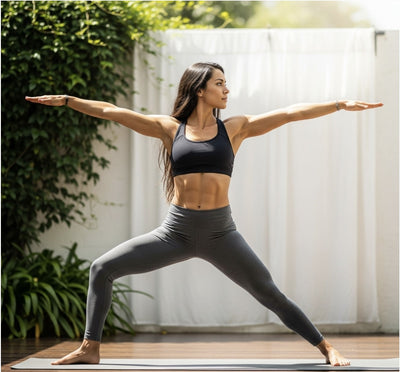
Raja Yoga: The Path of Mental Control According to Patanjali - 5To9Style
Share
Raja Yoga: The Path of Mental Control According to Patanjali
Introduction
When most people think of yoga, they often picture physical postures. However, yoga is a vast and ancient philosophy with many branches. One of the most significant and profound is Raja Yoga, often referred to as the "Royal Path" or the "King's Path." Codified by the sage Patanjali in his seminal text, the Yoga Sutras, Raja Yoga is primarily concerned with mental control and the disciplined journey towards inner peace, self-realization, and ultimately, liberation. Unlike other paths that might focus more on devotion or action, Raja Yoga provides a systematic approach to stilling the mind's fluctuations, leading to profound clarity and stillness.
Understanding Raja Yoga and Patanjali's Yoga Sutras
The term "Raja" signifies its supreme nature among yogic paths, emphasizing mastery over the mind. Patanjali's Yoga Sutras, compiled around 400 CE, serve as the foundational text for Raja Yoga. This concise yet comprehensive work outlines an "eight-limbed path" (Ashtanga Yoga) as a practical framework for achieving self-mastery and inner tranquility. It's important to note that the Ashtanga Yoga described by Patanjali is a broad philosophical system, not to be confused with the modern physical style of Ashtanga Vinyasa Yoga.
The Eight Limbs of Raja Yoga (Ashtanga Yoga)
Patanjali's eight limbs offer a progressive blueprint for living a disciplined and mindful life, culminating in a state of deep meditation and liberation.
1. Yamas (Ethical Restraints): These are universal moral commandments, guiding our behavior towards others and the world. They include:
Ahimsa (non-violence)
Satya (truthfulness)
Asteya (non-stealing)
Brahmacharya (moderation, often interpreted as self-restraint or right use of energy)
Aparigraha (non-possessiveness, non-greed)
Why they're important: The Yamas create a foundation of ethical conduct, essential for inner peace and harmonious living.
2. Niyamas (Observances): These are personal observances, guiding our behavior towards ourselves. They include:
Saucha (purity, cleanliness)
Santosha (contentment)
Tapas (discipline, austerity)
Svadhyaya (self-study, study of sacred texts)
Ishvara Pranidhana (surrender to a higher power or divine will)
Why they're important: The Niyamas cultivate self-discipline and positive habits that foster personal growth and well-being.
3. Asana (Posture): In Patanjali's context, asana refers specifically to a stable and comfortable meditative posture (like a cross-legged seat), suitable for long periods of stillness. It's not about the myriad of physical poses found in Hatha Yoga.
Why it's important: A steady posture is crucial for a steady mind during meditation.
4. Pranayama (Breath Control): The conscious regulation of the breath to control and expand prana (life force energy). Techniques involve directing and extending the inhalation, exhalation, and retention of breath.
Why it's important: Breath is seen as the link between the body and mind. Controlling the breath helps to quiet mental fluctuations.
5. Pratyahara (Withdrawal of the Senses): The turning inward of the senses, detaching from external distractions. It's about drawing attention away from sensory input and focusing it internally.
Why it's important: Pratyahara prepares the mind for deeper states of concentration and meditation.
6, Dharana (Concentration): Fixing the mind on a single point or object, without wavering. This could be a mantra, an image, or a point within the body.
Why it's important: Dharana is the initial stage of true meditation, training the mind to sustain focus.
7. Dhyana (Meditation): The continuous flow of concentration, where the mind remains effortlessly fixed on the object of meditation without interruption. It's a state of deep, sustained contemplation.
Why it's important: Dhyana is the pinnacle of mental control, leading to profound insights and inner stillness.
8. Samadhi (Absorption / Super-Conscious State): The ultimate limb, where the meditator merges with the object of meditation, transcending all duality and experiencing a state of pure bliss and liberation.
Why it's important: Samadhi represents the goal of Raja Yoga – self-realization and ultimate freedom.

The Path of Mental Mastery in Modern Context
While Raja Yoga focuses on strict mental discipline, its principles are highly applicable to modern life. The emphasis on ethical living (Yamas and Niyamas), breath control (pranayama), and concentration exercises provides practical tools for navigating daily challenges.
Stress Reduction: By teaching us to observe and manage our thoughts, Raja Yoga offers powerful techniques to reduce stress and anxiety.
Enhanced Focus: Practicing Dharana and Dhyana can significantly improve concentration, benefiting work, study, and daily tasks.
Emotional Regulation: The self-awareness cultivated through these practices helps in understanding and managing emotions more effectively.
Mindful Living: The Yamas and Niyamas provide a moral compass for living a more purposeful and harmonious life.

Supporting Your Raja Yoga Journey with 5to9 Style
Even though Raja Yoga emphasizes mental and internal practices, physical comfort plays a role, especially when sustaining meditative postures. Distractions from uncomfortable clothing can hinder your focus. 5to9 Style understands the need for unrestricted movement and ultimate comfort, which is why our yoga wear is designed with your deepest practices in mind.
Our breathable, flexible yoga pants and sports bras ensure you can sit comfortably for extended periods, allowing your mind to focus solely on your internal journey without physical discomfort. Explore our collection of activewear at https://5to9style.com/collections/all to find the perfect yoga clothing that supports your pursuit of mental control and inner peace.
Conclusion
Raja Yoga, as outlined by Patanjali, offers a profound and systematic path to mental control, self-mastery, and ultimate liberation. By diligently practicing its eight limbs, practitioners cultivate ethical living, physical stability, breath mastery, sensory withdrawal, deep concentration, and ultimately, a state of profound meditation and absorption. This ancient wisdom provides invaluable tools for anyone seeking to navigate the complexities of modern life with greater clarity, peace, and purpose. Embrace the Royal Path and unlock the inherent stillness within.
Ready to support your journey on the Royal Path? Discover our premium yoga wear designed for comfort and focus at https://5to9style.com/collections/all. Visit our homepage at https://5to9style.com to learn more about 5to9 Style and find attire that elevates your practice.








